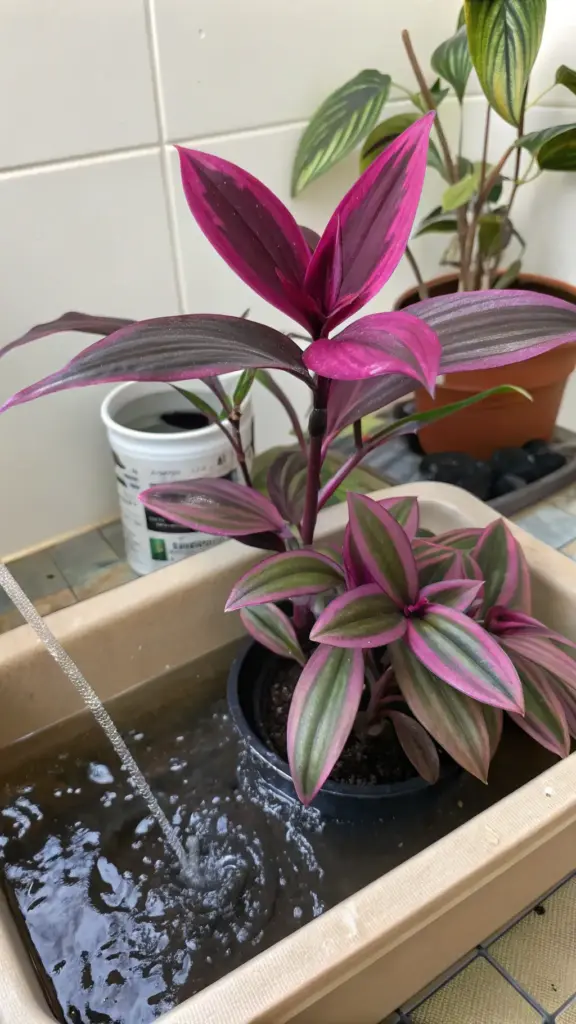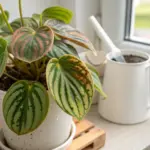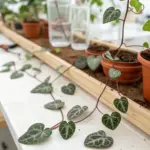3. Strategic Watering for Color Enhancement

I almost killed my prized Nanouk trying to perfect my watering game. Seriously, I went from overwatering to underwatering so many times that I’m surprised the poor thing survived my learning curve.
But here’s the crazy part – some of my biggest “watering mistakes” actually led to the most incredible color displays I’d ever seen.
That’s when I discovered stress watering wasn’t actually a mistake at all.
The Stress Watering Secret That Changes Everything
Controlled drought stress sounds scary, but it’s honestly the most powerful tool for color intensification I’ve ever used. When your Nanouk gets slightly stressed from less frequent watering, it pumps out more protective pigments.
Think of it like a plant’s survival mode. The slight stress triggers more anthocyanin production to protect the leaves from potential damage.
I let my soil dry out about 80% before watering instead of the usual 50-60%. The difference in pink and purple intensity was absolutely mind-blowing.
Don’t let it get bone dry though. I learned that lesson when my beautiful trailing stems started getting crispy edges.
Reading Your Plant’s Colorful Water Signals
Your Nanouk literally tells you what it needs through leaf color changes – you just have to learn the language. When mine needs water, those pink stripes actually get more vibrant before they start to fade.
It’s like the plant’s last-ditch effort to protect itself with extra pigments. This usually happens when the soil is about 70-80% dry.
Overwatered leaves lose their color intensity and look kind of washed out. The pink becomes pale, and the whole plant looks less dramatic.
I stick my finger about 2 inches into the soil, but honestly, watching the leaf coloration became my most reliable watering gauge.
Bottom Watering vs Top Watering Drama
I was a top watering person for years until I discovered how much better bottom watering works for color development. The roots get exactly what they need without shocking the plant.
Here’s my bottom watering setup: I use a shallow tray filled with about an inch of water and let the plant soak it up for 30-45 minutes.
The root health improvement was incredible. Stronger roots mean better nutrient uptake, which directly impacts those gorgeous pigment concentrations.
Top watering can wash nutrients out of the soil too quickly. Bottom watering keeps everything where the plant can actually use it.
My Color-Boosting Watering Schedule
Consistency with strategic stress became my mantra. I water every 7-10 days during growing season, but I let the plant tell me when it’s ready.
Spring watering happens more frequently because of active growth. I stick to every 5-7 days when I see new pink growth emerging.
Winter watering drops to every 10-14 days. The cooler temperatures and lower light mean slower growth and less water needs.
I keep a plant journal tracking watering dates and color intensity. The patterns became super obvious after about two months of consistent tracking.
The Water Quality Game-Changer
Tap water was slowly dulling my Nanouk’s colors, and I had no idea why. Our city water has high chlorine and fluoride levels that apparently interfere with pigment production.
Switching to filtered water made a difference within three weeks. Those pink stripes became more defined and vibrant.
Distilled water works great too, but I add a tiny bit of liquid fertilizer since it lacks natural minerals. Pure water can actually leach nutrients from the soil over time.
I fill up gallon jugs and let tap water sit for 24 hours to let chlorine evaporate. It’s cheaper than buying filtered water constantly.
Humidity’s Secret Role in Color Vibrancy
Low humidity was sabotaging my color game without me realizing it. When the air gets too dry, plants close their stomata and can’t process nutrients properly.
Ideal humidity for Nanouk colors sits around 50-60%. Most homes hover around 30-40%, especially during winter heating season.
I use a humidity tray filled with pebbles and water under my plant. As the water evaporates, it creates a perfect microclimate.
Grouping plants together naturally increases humidity through transpiration. My plant corner stays about 10-15% more humid than the rest of my living room.
Watering Mistakes That Kill Colors
Inconsistent watering is probably the biggest color killer I see. Going from bone dry to soaking wet stresses plants in all the wrong ways.
Watering with ice-cold water shocked my plant so badly that new growth came in completely green. Room temperature water is always the way to go.
Overwatering during winter when growth slows down leads to root rot and faded colors. I learned to cut back significantly during dormant months.
Using hard water with high mineral content can build up in soil and interfere with nutrient absorption. Those gorgeous pigments need proper nutrition to develop.
My Biggest Watering Breakthrough
The game-changer was realizing that slight underwatering actually enhances colors while slight overwatering kills them. It goes against everything I thought I knew about plant care.
I started treating my Nanouk more like a succulent during color-boosting phases. Less frequent, deeper watering sessions worked so much better.
Seasonal adjustments became crucial. What works in humid summer months fails miserably during dry winter heating season.
The most important lesson? Your plant’s color response tells you more about watering success than any moisture meter ever could.
Ready to supercharge those colors even more? The next secret involves a fertilizer formula that most plant parents get completely wrong – and it’s costing them those vibrant pink hues! Discover the low-nitrogen trick that prevents green dominance and unlocks your Nanouk’s full color potential. Click “next” to learn this professional feeding strategy!









GIPHY App Key not set. Please check settings